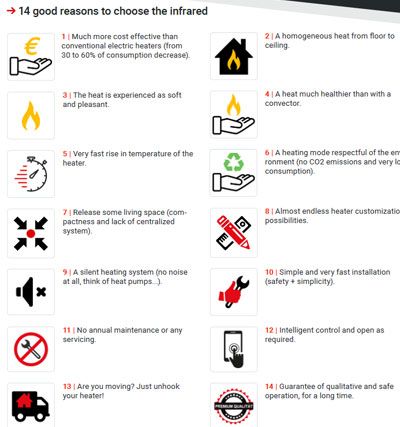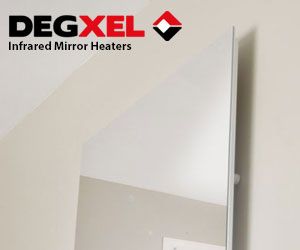Innovative Heating: should we choose the far infrared heaters (FIR)?
Share this page
Summary expert file “Far InfraRed Heater – FIR”:
Infrared heating operating principle
Near Infrared NIR or Far Infrared FIR?
Comfort and infrared heaters
The infrared heater another step closer to the low consumption
Criteria for a successful project. Pitfalls to avoid.
The Infrared Heating Principle
The infrared is widespread in everyday life (industry, health, home). In this article we are going to focus only on the field of heating.
The so-called “infrared” heaters are electric radiant heaters. What distinguish them from classical radiant heaters is their performance.
Most heaters (and more generally heat emitters) produce heat mainly by convection. The air heats up in contact with the heat emitter then accumulates under the ceiling and progressively fills the volume of the room. The principle of the infrared is, instead, to minimise the convective effect and maximise the radiation effect. Read more about the convection.
Therefore the infrared heating is a radiant heating which performances allow to produce at least 50% of infrared (so 50% of convection).
But what is the radiation? It is the fact of transmitting the heat without contact. Well known is the principle of the sun in winter that heats you up while you are outside and the temperature shows 0°C – the heat reaches you without contact. This principle was discovered by physicist Herschel in the 18th century. The infrared heaters reproduce this principle based on electricity.
It is sometimes wrongly understood that if you cut the heating (thus the radiation)….
To know more about the heating by radiation.
Near Infrared NIR or Far Infrared FIR?
There are 2 ranges of infrared heating:
- the short/medium wavelength infrared (IR-B),
- the far infrared (IR-C) also called by other names (FIR, biotic heating…).
The short wavelenght infrared is well known in the field of heating. We can find them on the terraces of coffee shops, restaurants, verandas, winter gardens, in bathrooms, etc:
- they emit infrared waves whose range is between 2.5 and 3 meters. Depending on the shape of the heater it creates a “heat bubble” (cone, pyramid, etc.). All that is within that area will directly feel the heat. Everything outside of that zone is not heated. The heating is called directional.
The far infrared is far less known in the UK. The Austrian manufacturers, cutting edge in technology related to renewable energies and self-consumption are the creators. Year after year they are gaining market share:
- they emit infrared waves of much longer range (4 to 5 meters for the leaders).
- they are intended for inside heating. It does not heat the air directly, but indirectly. The building (floor, ceiling, walls, …) stores the energy and then releases it at low temperature. So the air is heated gradually. The energy is uniformly stored in the building. This technique has many advantages in comfort and consumption.
Comfort and infrared heaters
The infrared heaters (quality ones!) offer an excellent thermal comfort.
There are many parameters that influence the thermal comfort within the residential heating. There are 3 parameters among them that are directly influenced by the infrared:
- the temperature variation between floor and ceiling
- the temperature difference between the walls (walls, floor, ceiling) and the room temperature
- the circulation of air in the room
The high-end heaters mainly emit radiation and not convection heat. This means that the temperature difference between the floor and the ceiling will be greatly reduced (see the comparison table below). The stored energy in the walls (floor, walls, ceiling) will be redistributed at low temperature, so the walls will be warmer. It is scientifically demonstrated that smaller the temperature difference between the walls and the ambient air is, the greater the comfort is (source “building thermal analysis DUNOD editions”).
The air circulation is greatly reduced (as well as the stirring of allergens) compared to conventional convectors. Additionally the air is not dried up.
The far infrared heater: another step closer to low consumption
The far infrared heaters (high-end!) allow to reduce the electric consumption in the order of 30 to 40% compared to conventional convectors. Why?
- there is no need to unnecessarily heat the entire volume of the room (especially if the ceiling height is important).
- in terms of feeling (sensation), it is shown that at equal comfort, the radiation allows to heat at 1°C less, that is 7% of consumption less. With the infrared, heat to 19°C for a feeling of 20°C.
- contrary to preconceived ideas, not all heaters transform the electricity with the same efficiency. Powerful infrared heaters allow to reduce the bill if the power requirements are correctly estimated and installed according to the rules of art.
Criteria for a successful project, pitfalls to avoid.
As with conventional heaters the far infrared heaters are very variable in quality.
To trust a manufacturer with the criteria below is essential for the success of your project, in terms of quality as well as reliability, safety and low consumption.
The criteria:
- a radiation rate of more than 50% (that is rarely achieved by heaters which incorporate carbon-based films). Unfortunately the radiation rate is very rarely announced or fanciful. Verify the announced values. A good way to scientifically verify the radiation rate is the heater surface temperature. If it is less than 75-80°C, no doubt the radiation rate will be lower (or even much lower) to 50%. Note that the “so-called infrared” heaters that can be found in supermarkets for less than 200£ have a radiation rate of 10% to 30%! Remember, this radiation rate will directly influence the consumption of your customer and his comfort.
- a metal front or at least of the same material as the frame of the heater to avoid the problems of expansion between 2 metals. This point is important, because it has been reported that heaters (including ceiling mounted) have a front that detached from the frame.
- the presence, essential, of an insulation at the rear of the heater to force the radiation forward (and not backward to the wall).
- the advice in terms of ideal positioning. The basic rule is that all areas of the rooms are achieved by the radiation.
- the announced warranty period and the after sale service.
The Austrian manufacturers being at the historical origin of this type of heating, their expertise is recognised in the field. There are no UK manufacturers whose radiation rate is higher than 50%.
For a quality product, reckon with 1000£ to heat 25 to 30 m2 depending on the level of insulation. The price rise accordingly to the finish or desired customisation of the heater (mirror, bespoke decoration, glass, natural stone, etc.).
FOX6



